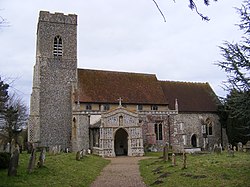Huntingfield, Suffolk
| Huntingfield | |
|---|---|
 Huntingfield, Church of St Mary |
|
| Huntingfield shown within Suffolk | |
| Population | 188 (2011) |
| District | |
| Shire county | |
| Region | |
| Country | England |
| Sovereign state | United Kingdom |
| Post town | Halesworth |
| Postcode district | IP19 |
| Police | Suffolk |
| Fire | Suffolk |
| Ambulance | East of England |
| EU Parliament | East of England |
Huntingfield is a village near the B1117 road, in the Suffolk Coastal district, in the county of Suffolk, England. The village is close to the source of the River Blyth and the parish is 12 miles from the seaside town of Southwold. Nearby settlements include the town of Halesworth and the villages of Walpole, Heveningham, Cookley and Laxfield.
In 1870–72 John Marius Wilson described Huntingfield as,
"a village and a parish in Blything district, Suffolk. The village stands 4½ miles SW of Halesworth r. station. The parish comprises 2,134 acres; and its post town is Halesworth".
Huntingfield was listed in the Domesday Book in the Hundred of Blything. The parish was written in the Domesday Book as Huntingafelda.
Data from the first UK census in 1801 is available for the parish of Huntingfield. In 1801 it was recorded the population of Huntingfield was 373. The highest population was recorded in 1851,with a population of 411. However, since then, the population has slowly declined. The census data showed the population in 2011 in Huntingfield was 188. This data is shown in the graph below and shows the total population of Huntingfield from 1801–2011.
Housing records for Huntingfield from 1831 to 1961 show the number of houses vacant and occupied during this time. The number of vacant houses in Huntingfield went from zero to five, with the highest number of houses occupied in 1851.
In 2005, a sign was designed by a local resident, David Gentleman. The sign stands on the village green and is a distinctive feature of the village.
Nowadays Huntingfield has remained a rural parish and covers a large area that is sparsely populated. The area is mainly agricultural and is dotted with farmhouses and dwellings.
The 2011 census showed the population of Huntingfield ranged from 0–93 years of age. The most common age within the village in 2011 was 56. Huntingfield is also home to young people and families. In 2011, 39 people under the age of 18 were shown to be living within the parish.
The 2011 census shows Huntingfield doesn't have much cultural diversity as 108 out of its 188 population are of a Christian background. One person is of a Jewish religion while 79 people within the parish have non-or not stated their religion.
The healthcare in the area of Huntingfield appears to be prominently good with 48.4% of the population having very good health compared to 2.2% of the population having bad to very bad health.
The church of St Mary is a fine example of East Anglian late Medieval work. The church is a Grade 1 listed building and dates from around the 11th century. The church often attracts visitors due to the beautifully painted ceiling. The ceiling was painted by Mildred Holland, the wife of William Holland who was the rector of the parish for 44 years through the years 1848–1892. Holland painted the Chancel roof in the style of the 15th century and during her work, the church was closed for eight months from September 1859 to April 1860. Three years later, Mildred painted the nave and other furnishings of the church. Some of the more recent painted furnishings are as a tribute to her.
...
Wikipedia

